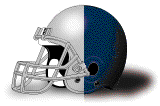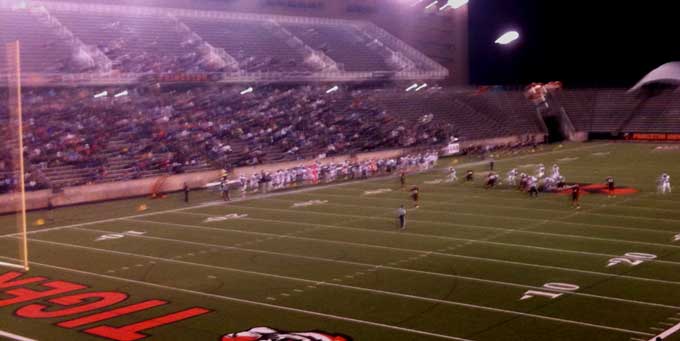In case you're wondering, no one left --or joined-- the Big East conference this weekend.
Which raises this question--what would it take for either Villanova or Georgetown to be a more serious player in these tectonic shifts? Football, of course, yet neither plays at the competitive level needed to either lead the Big East or be a candidate for another major conference.
So what if the two schools got together to field a Big East team?
(Please, it's only a parody. In the Internet age it doesn't take much for an story to go viral in the wrong way.)
BIG EAST Announces Debut of Georgetown University and Villanova University
In Innovative Football Partnership
PROVIDENCE, Nov. 31 -- The BIG EAST Conference has announced the addition of Georgetown University and Villanova University as a single conference entity that will compete in the BIG EAST in the sport of football.
 The BIG EAST extended an invitation to S.J.-O.S.A., LLC, a joint venture between the universities, to operate a unified football team (to be known as "Georgetown and Villanova" or "G&V") comprising football student-athletes of both universities at the Football Bowl Subdivision (FBS) of NCAA competition. G&V will begin BIG EAST football competition in the 2015 season along with the U.S. Naval Academy, who joins the league that season.
The BIG EAST extended an invitation to S.J.-O.S.A., LLC, a joint venture between the universities, to operate a unified football team (to be known as "Georgetown and Villanova" or "G&V") comprising football student-athletes of both universities at the Football Bowl Subdivision (FBS) of NCAA competition. G&V will begin BIG EAST football competition in the 2015 season along with the U.S. Naval Academy, who joins the league that season.The combined team will compete under the nickname "Hoya-Cats". The team’s colors will be blue, white, and gray, reflective of the common colors of both institutions. Each school will maintain its own records and the team will represent both universities as its sole intercollegiate football entity after the 2014 season.
"We are very excited to welcome Georgetown University and Villanova University into the BIG EAST Conference for football," said a conference official. "Each of these schools have a strong athletic tradition and an innovative plan of friendly competition that will help elevate our football league. Each University is an outstanding academic institution that continue to reflect the values and responsibilities of their long held membership in the BIG EAST conference."
Villanova and Georgetown compete within the Football Championship Subdivision (FCS) of NCAA Division I football, but each lacked the resources to make a jump to the FBS under its current funding and scholarship models. The combined team will have the full scholarship and facility resources necessary to compete at the highest level of intercollegiate football and allow the BIG EAST to sponsor an even number of teams by division.
The combined FBS entity will compete at the 85 scholarship limit mandated by the FBS. Approximately 60 of the scholarships will initially be supplied by Villanova, 25 by Georgetown. The team will host six home games annually, three at FedEx Field outside Landover, MD (Georgetown) and three at Lincoln Financial Field in Philadelphia, PA (Villanova). In addition, an annual game with Temple will alternate between home and away at Lincoln Financial Field, giving G&V seven home opportunities annually between its two cities.
Practice facilities will be established at both schools with team offices headquartered at Villanova.
The student-athletes are admitted to the school of their choice and will receive degrees from either Georgetown or Villanova. Through a dual degree program to be announced, each school will offer a program whereby a student-athlete can take the first three years of classes at either Georgetown or Villanova to receive a bachelor’s degree and conclude his intercollegiate eligibility at the second school for the pursuit of an MBA.
In conjunction with the joint venture and the athletic departments of the universities, a combined coaching staff for the 2015 season will be named at a later date. The schools will continue to field a full complement of BIG EAST sports independently of each other.
With the combined addition, the BIG EAST football membership will now be in 14 states, 13 of the top 50 Nielsen media markets and eight of the top 25 media markets. The conference will have a television households reach of 31.3 million - by far the largest number in college football.



